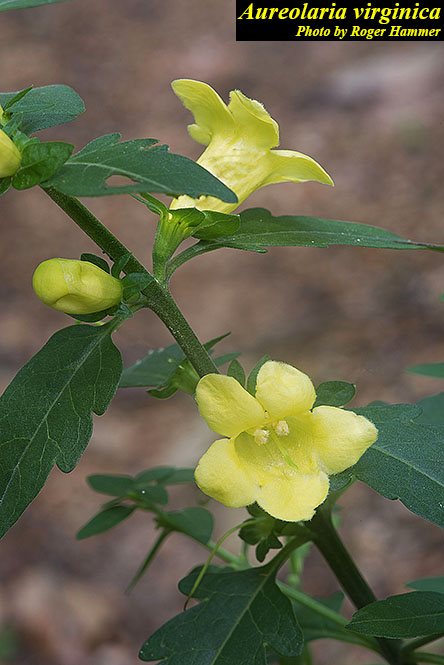Aureolaria virginica
| Aureolaria virginica | |
|---|---|

| |
| Photo by Roger Hammer, Atlas of Florida Vascular Plants | |
| Scientific classification | |
| Kingdom: | Plantae |
| Division: | Magnoliophyta - Flowering plants |
| Class: | Magnoliopsida - Dicotyledons |
| Order: | Scrophulariales |
| Family: | Scrophulariaceae |
| Genus: | Aureolaria |
| Species: | A. virginica |
| Binomial name | |
| Aureolaria virginica (L.) Pennell | |

| |
| Natural range of Aureolaria virginica from USDA NRCS Plants Database. | |
Common names: Downy yellow false foxglove; Downy oak-leech; Virginia oak-leech
Contents
Taxonomic notes
Synonyms: Gerardia virginica (Linnaeus) Britton, Sterns, & Poggenburg; A. microcarpa Pennell.[1]
Varieties: none.[1]
Description
In the genus Aureolaria, the plants are either annual or perennial. They are parasitic on the roots of Quercus (oaks) and they turn black when dried. The cauline leaves are opposite or subopposite. The flowers are showy, the calyx is 5-parted, the lobes are shorter to longer than the tube. The corolla is yellow in color, bilabiate, and 5-parted. The tube is campanulate and the lobes are spreading. There are 4 stamens, didynamous, included, filaments are flattened, and the 2 longer more or less lanose. The anther sacs are basally awned. The stigma is capitate and exserted.[2]
Specifically for A. virginica, they’re perennial parasitic plants of the white oak group. The stems are pubescent, weakly branched or unbranched altogether, and grow to approximately 1 m or more tall. The leaves are lanceolate or ovate-lanceolate, entire or coarsely sinuate to pinnately lobed or parted, puberulent, or weakly tomentose, and most are 6-12 cm long, 1.5-4.5 cm wide. The terminal raceme has distinct, flowers that are solitary in the axils of opposite bracts. The pedicels are glabrous and most of the time less than 3 mm long at the anthesis. The calyx lobes are lanceolate, equaling or much longer than the tube, approximately 3-10 mm long, and is entire. The corolla is 3.5-4.5 cm long. The capsule is broadly ovoid, 1-1.5 mm long, are pubescent. The pedicels are 6 mm long. The seeds have several irregular, narrow, hyaline wings. Flowers from May to July; then August to September.[2]
Distribution
Listed as critically imperiled in New Hampshire, Vermont and Ontario.[3]
Ecology
Habitat
A. virginica has been found in creek slopes, oak-pine slopes, and areas with loamy sand.[4] It is also found in disturbed areas such as along roadsides.[5] Associated species: Cyperus croceus, Acalypha gracilens, Woodwardia areolata, Quercus alba, Quercus michauxii, Liquidambar, Acer rubrum, and Ruellia caroliniensis.[6][5]
Phenology
The yellow, flower blooms June through August.[7] This is a polycarpic, hemiparasitic species. It is hemiparasitic because it is autotrophic and able to grow to maturity without attaching to a host. Primary hosts include white oaks, however, Carya and Nyssa are also susceptible. A. virginica attaches to a host through modified roots called haustoria.[8]
Seed bank and germination
Seeds display innate dormancy, which can be broken by exposure of imbibed seeds to appropriate cold stratification conditions. Germination is epigeal with the radical emergence about four days after sowing.[8]
Pollination and use by animals
Aureolaria virginica has been observed hosting many types of pollinators, including members of the Andrenidae family such asAndrena hirticincta and Perdita octomaculata, members of the Apidae family such asApis mellifera and Bombus impatiens, and members of the Colletidae family such as Colletes simulans and C. thysanellae.[9] Additionally, A. virginica hosts a variety of insects such as members of the Acanaloniidae family such as Acanalonia conica and A. servillei, Aphis sp. (family Aphididae), Stobaera pallida (family Delphacidae), Ormenoides venusta (familty Flatidae), Micrutalis calva (family Membracidae), Lygus lineolaris (family Miridae ), and Pelitropis rotulata (family Tropiduchidae).[10]
Conservation, cultivation, and restoration
Cultural use
Photo Gallery
References and notes
- ↑ 1.0 1.1 Weakley, A.S. 2015. Flora of the southern and mid-atlantic states. Working Draft of 21 May 2015. University of North Carolina at Chapel Hill, Chapel Hill, North Carolina.
- ↑ 2.0 2.1 Radford, Albert E., Harry E. Ahles, and C. Ritchie Bell. Manual of the Vascular Flora of the Carolinas. 1964, 1968. The University of North Carolina Press. 956-7. Print.
- ↑ [[1]]NatureServe. Accessed: April 1, 2016
- ↑ Florida State University Herbarium Database. URL: http://herbarium.bio.fsu.edu. Last accessed: May 2021. Collectors: R. Kral. States and counties: Alabama: Clay. Tennessee: Marion.
- ↑ 5.0 5.1 Arizona State University Vascular Plant Herbarium accessed using Southeastern Regional Network of Expertise and Collections (SERNEC) data portal. URL: http://sernecportal.org/portal/collections/index.php Last accessed: May 2021. Collectors: R.S. Freer and D.R. Windler. States and Counties: Maryland: Charles. Virginia: Augusta.
- ↑ Louisiana State University, Shirley C. Tucker Herbarium accessed using Southeastern Regional Network of Expertise and Collections (SERNEC) data portal. URL: http://sernecportal.org/portal/collections/index.php Last accessed: May 2021. Collectors: Stephanie M. Gunn-Zumo. States and Counties: Mississippi: Jackson.
- ↑ [[2]]Lady Bird Johnson Wildflower Center. Accessed: April 1, 2016
- ↑ 8.0 8.1 Cite error: Invalid
<ref>tag; no text was provided for refs namedking - ↑ Discoverlife.org [3]
- ↑ Discoverlife.org [4]